Welcome to our comprehensive guide on growing lettuce and salad mix in hydroponics! If you’re eager to embark on a rewarding journey of cultivating fresh and delicious greens, you’ve come to the right place. This step-by-step tutorial’ll walk you through the process with clear and concise instructions. Hydroponics, the practice of growing plants without soil, offers numerous advantages, such as faster growth, higher yields, and minimal space requirements.
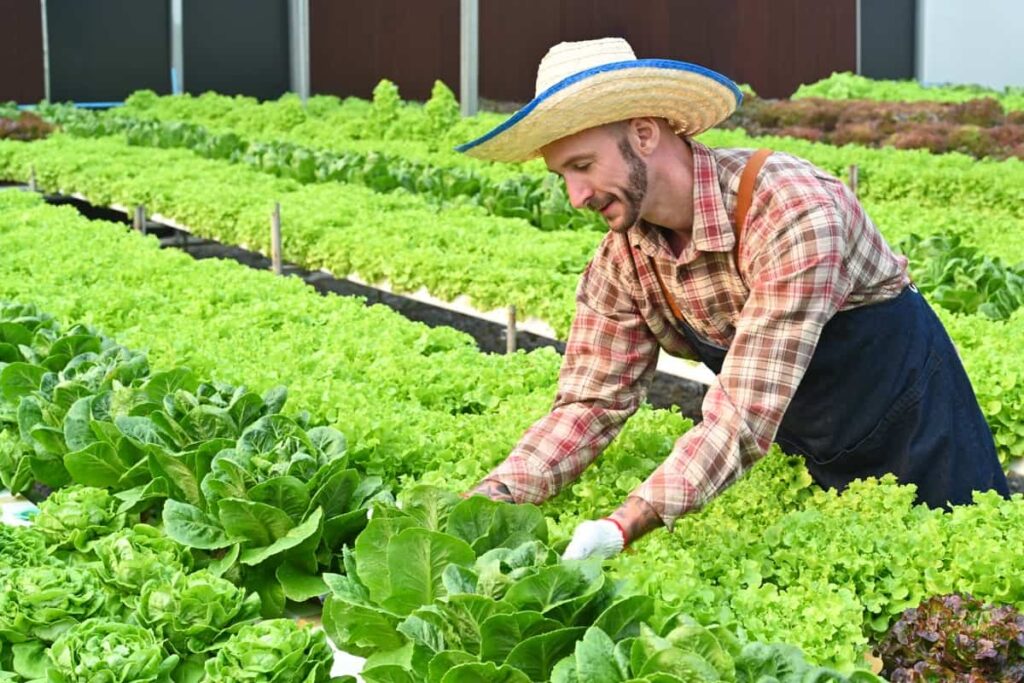
How to Grow Lettuce and Salad Mix in Hydroponics
What is Lettuce and Salad Mix in Hydroponics
Lettuce and salad mix are leafy greens that can be grown in hydroponic systems which don’t use soil. Hydroponics involves submerging the plant roots in nutrient-rich water. Lettuce (Lactuca sativa) is a cool-season crop that does well in controlled environments. The salad mix combines lettuce varieties, including Romaine, leaf, butterhead, and other greens like spinach and arugula. These greens contain vitamins A, C, and K and minerals like calcium and iron. Hydroponics offers fast growth, high yields, and less water usage than traditional soil-based methods.
Hydroponic Lettuce and Salad Mix Cultivation
Lettuce is an ideal vegetable, to begin with in hydroponics due to its easy cultivation. Within a few weeks, you can set up your hydroponic system, care for the plants, and harvest your first lettuce crop. Once you grasp the basics, you can enjoy homegrown lettuce throughout the year. To start, choose the type of lettuce you prefer. Most lettuce varieties can be grown hydroponically, such as Tom Thumb for compact spaces, Bibb lettuce for easier cultivation, or Romaine, which requires more time.
Each variety has its specific requirements and characteristics. Next, select a water culture system, where plants float on the water while their roots absorb nutrients. This system is effective and straightforward. Choose a growing medium, such as rockwool or coco fiber, to support the plants’ roots. Rockwool is popular due to its sterility and porosity, but it ensures it stays saturated to prevent root suffocation and rot.
Use a large container or fish tank with sufficient depth for root growth for the nutrient reservoir. Avoid metal containers as they can release chemicals that disrupt nutrient supply. Set up net pots or floating platforms using materials like styrofoam or the lid of the reservoir container. These will keep the plants stable with their roots submerged in water. To provide necessary aeration, use an aquarium pump in the reservoir to prevent root suffocation.
In case you missed it: How to Grow Edible Flowers in Hydroponics: A Step-By-Step Guide for Beginners
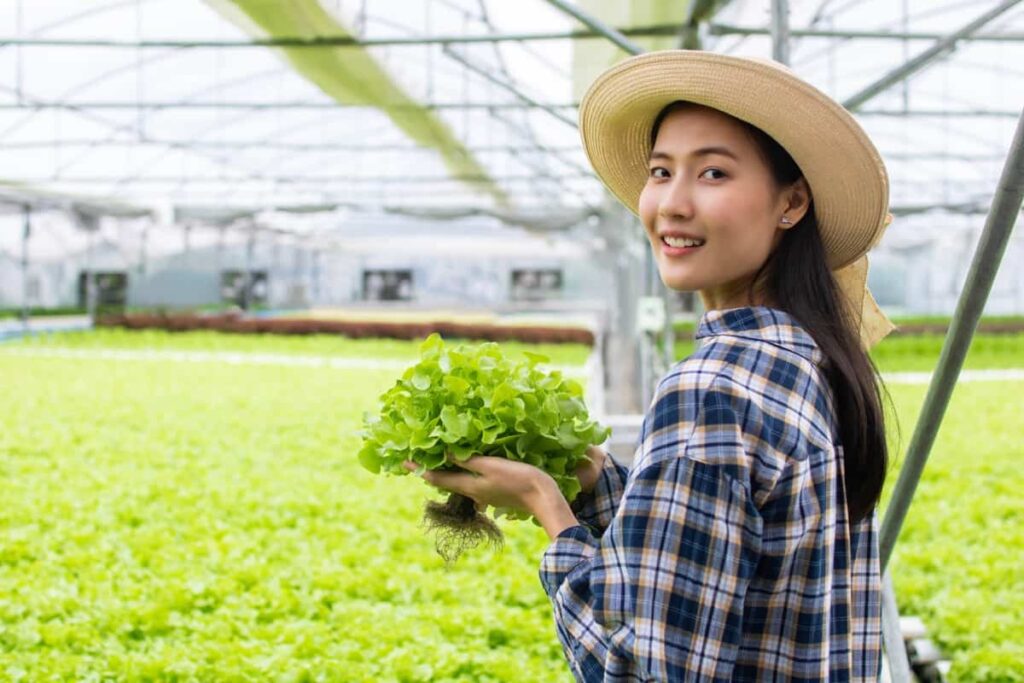
Create a nutrient mixture specifically formulated for hydroponic plants, following the instructions provided with the nutrient kit. Lettuce typically requires higher potassium, calcium, and magnesium levels, so ensure the nutrients are appropriate for your chosen lettuce type. Before transferring the seedlings to the hydroponic system, create a nursery using an egg carton or plugs filled with your chosen medium and hydroponic seeds.
Water the nursery every other day and place it in a well-lit area with temperatures between 65° and 80° Fahrenheit (18.3-26.6° Celsius) until the seedlings reach a height of 2 inches (5 cm) with four leaves. Once the seedlings are ready, transplant them carefully to the reservoir’s net pots or floating platforms. Provide the lettuce plants with 10-14 hours of fluorescent light daily, as lettuce doesn’t require intense or prolonged exposure to grow.
Maintain a temperature range of 55 to 75° Fahrenheit (12.7-23.8° Celsius), ensuring it doesn’t get too hot to prevent the lettuce from bolting and developing a bitter taste. Check the pH of the nutrient solution and keep it between 5.5 and 6.5 for optimal nutrient absorption. Use pH adjusters to bring the pH back to the correct level if necessary. After approximately 5-6 weeks, when the lettuce is fully grown, harvest the outer leaves while leaving some inner leaves attached to the plant. This allows for continuous production.
Rotate which plants you pick from to maintain a consistent supply of lettuce. If you don’t plan to consume the lettuce immediately, keep the rooted plants in a cold, humid environment to preserve their freshness for up to a month. To manage pests and diseases, ensure proper air circulation to prevent bacteria and mildew by keeping doors or windows open or installing vents or fans. Use screens and sticky traps to deter insect pests, minimize direct sunlight to prevent algae growth, and sterilize equipment to prevent water-borne molds.
Benefits of Growing Lettuce and Salad mix Hydroponically
- Year-round availability: Hydroponic lettuce can be grown indoors, allowing for consistent harvests regardless of the season.
- Space-efficient: Hydroponics requires minimal space, making it suitable for urban environments or limited yard space.
- Water conservation: Hydroponics uses up to 90% less water compared to traditional soil-based farming.
- Faster growth: Lettuce cultivated hydroponically grows faster, resulting in quicker harvests.
- Reduced pests and diseases: The controlled environment of hydroponics minimizes the risk of pests and diseases, reducing the need for pesticides.
- Higher yields: Hydroponic lettuce yields are typically higher compared to traditional farming methods.
- Nutrient control: With hydroponics, precise nutrient solutions can be the specific needs of lettuce, promoting healthier and more nutrient-rich plants.
- Soil-free cultivation: Hydroponics eliminates soil-related issues such as contamination, nutrient depletion, and soil-borne diseases.
- Sustainability: The efficient use of resources in hydroponics, such as water and space, contributes to a more sustainable and environmentally friendly farming method.
- Freshness and quality: Homegrown hydroponic lettuce offers unparalleled freshness and quality, providing a flavorful and nutritious addition to your meals.
In case you missed it: How to Grow Leafy Green Vegetables in Hydroponics: A Step-by-step Growing Guide
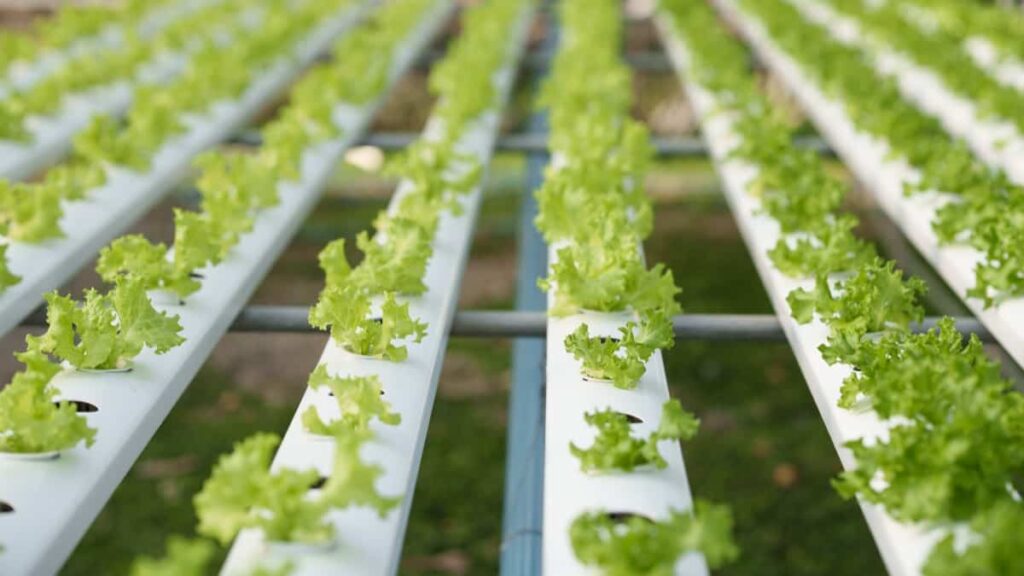
Best Hydroponic System for Growing Lettuce and Salad Mix
- Deep Water Culture (DWC) is used for lettuce and salad mix cultivation. Roots are suspended in nutrient-rich fluid. Beginners love the DWC system’s simplicity and efficacy.
- Fertilizer Film Technique (NFT) system: A thin film of fertilizer solution runs over plant roots, giving continual nutrients. NFT systems are water-efficient and suitable for lettuce growing.
- Aeroponic system: This innovative device sprays fertilizer mist on plant roots for optimal oxygenation and absorption. Aeroponic systems grow lettuce quickly and efficiently.
- Drip system: The nutrient solution drips slowly to plant roots. It grows lettuce in little and great quantities. Drip systems control nutrient delivery efficiently.
- Ebb and Flow system floods and drains plant roots with nutritional solution. This cycle oxygenates, nourishes, and prevents waterlogging. Ebb and flow systems grow lettuce and salad mix well.
- Vertical lettuce farming systems maximize space. NFT, DWC, and aeroponics can be used. Indoor farming with vertical systems yields more per square foot.
Optimal Nutrient Solution for Hydroponic Lettuce and Salad Mix
- The optimal nutrient solution for hydroponic lettuce and salad mix should contain high potassium, calcium, and magnesium levels.
- Maintain the pH of the nutrient solution between 5.5 and 6.5 for optimal nutrient absorption.
- Lettuce is sensitive to nitrogen levels, so choose a nutrient solution specifically formulated for lettuce cultivation.
- Follow the instructions provided with the nutrient kit to mix the nutrients accurately.
Tips for Successful Hydroponic Lettuce and Salad Mix Cultivation
- Choose the right lettuce varieties suitable for hydroponics, such as Tom Thumb, Bibb lettuce, or Romaine, based on your preferences and growing conditions.
- Set up a water culture system for efficient nutrient delivery and root growth.
- Select a suitable growing medium like rockwool or coco fiber to support the plants’ roots.
- Ensure proper aeration using an aquarium pump to prevent root suffocation.
- Maintain the pH level between 5.5 and 6.5 for optimal nutrient absorption.
- Provide 10-14 hours of daily fluorescent light to promote healthy growth.
- Keep the temp between 55 and 75° Fahrenheit (12.7-23.8° Celsius) for ideal lettuce development.
- Harvest outer leaves regularly, allowing inner leaves to grow and replace them.
- Maintain good air circulation to prevent bacterial and fungal diseases.
Common Problems and Solutions in Hydroponic Lettuce and Salad Mix Production
- Problem: Insufficient or excessive nutrients might impact plant growth and development.
- Solution: Regularly check and modify the nutrient solution to optimize lettuce growth.
- Problem: pH fluctuations can affect plant nutrient absorption.
- Solution: Use test kits and pH adjusters to keep the pH between 5.5 and 6.5.
- Pest infestation: Pests can damage lettuce plants and lower production.
- Solution: Use integrated pest management, including regular monitoring, biological controls, and organic insecticides.
- Hydroponic systems can transmit fungal or bacterial illnesses quickly.
- Solution: Sanitize equipment, remove and treat affected plants, and prevent disease spread.
In case you missed it: How to Grow Bok Choy Hydroponically: A Step-by-Step Guide for Planting to Harvesting

- Extreme temperature and humidity might harm lettuce development.
- Solution: Optimizing growing conditions using fans, ventilation, or temperature control.
- Root Rot: Caused by excess wetness or insufficient oxygenation.
- Solution: Avoid root rot using sterile media, ensuring sufficient drainage, aeration, and not overwatering.
- The light intensity can alter lettuce growth and development.
- Solution: Give plants 10–14 hours of light daily with artificial lights or natural sunlight.
- Nutrient Deficiencies: Problem: Lettuce might suffer from nutrient deficits and stunted development.
- Solution: Monitor plant health and appearance, adding micronutrients or adjusting nutrient ratios.
Indoor Hydroponic Techniques for Lettuce and Salad Mix
- Indoor hydroponic techniques provide an excellent way to grow lettuce and salad mix all year round.
- Choose a suitable indoor space with proper lighting, temperature, and ventilation for your hydroponic setup.
- Opt for a recirculating deep water culture (DWC) or nutrient film technique (NFT) system for efficient plant nutrient delivery.
- Select the appropriate lettuce varieties for indoor cultivation, such as Bibb, Romaine, or loose-leaf lettuce.
- Maintain a pH between 5.5 and 6.5 and provide the necessary nutrients, including potassium, calcium, and magnesium.
- Ensure adequate lighting with LED growth lights, providing 12-16 hours of light daily.
- Control the temperature between 65-75°F (18.3-23.8°C) during the day at night.
Managing Light and Temperature for Hydroponic Lettuce and Salad Mix
- Light: Provide 10-14 hours daily fluorescent light for lettuce growth. Fluorescent lighting is recommended due to its low cost, low power consumption, and low heat production.
- Temperature: Maintain temperatures between 55-75°F (12.7-23.8°C). Cooler temperatures around 55°F (12.7°C) at night and 75°F (23.8°C) during the day are ideal. Higher temperatures can cause lettuce to bolt and develop a bitter taste.
Harvesting and Maintaining Hydroponic Lettuce and Salad Mix
- Harvest outer leaves only to allow continuous production.
- Rotate picking from different plants to ensure a steady supply.
- Keep harvested lettuce fresh by storing it in a cold, humid environment.
- Ensure air circulation to prevent bacteria and mildew.
- Use screens and sticky traps to keep away insect pests.
- Minimize direct sunlight to prevent algae growth.
- Sterilize equipment to prevent water-borne molds.
- Monitor pH levels to ensure optimal nutrient absorption.
In case you missed it: Hydroponic Nutrient Chart: For Vegetables, Herbs, and Flowers
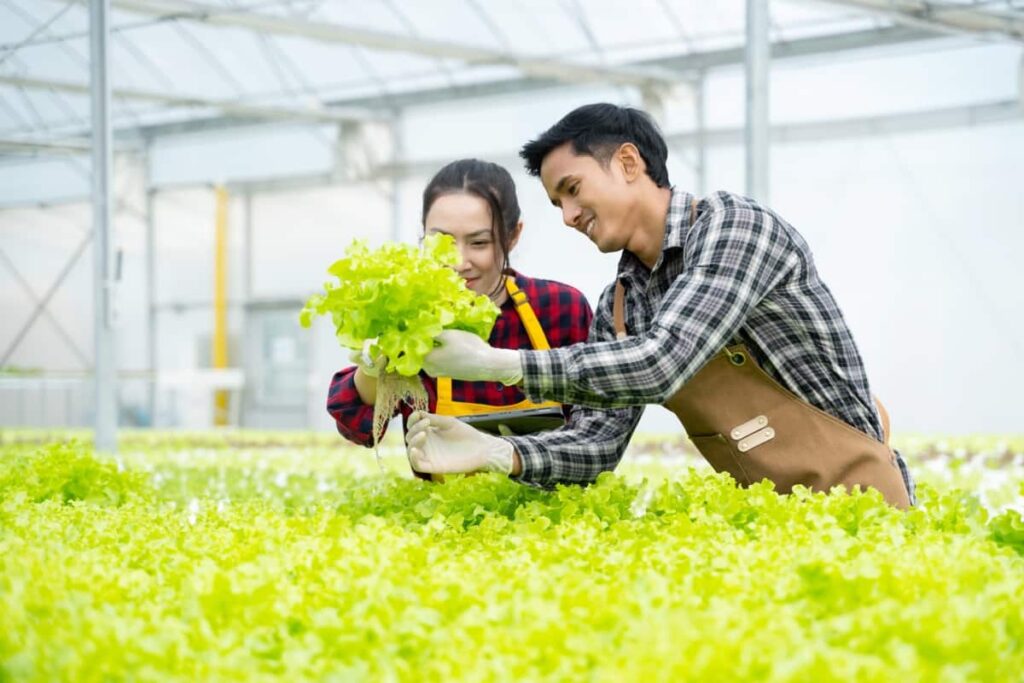
Hydroponic Nutrient Deficiencies in Lettuce and Salad Mix and Their Remedies
Nitrogen Deficiency
- Symptoms: Yellowing of older leaves.
- Remedy: Increase nitrogen levels in the nutrient solution or use a nitrogen-rich fertilizer.
Phosphorus Deficiency
- Symptoms: Dark green leaves with purplish hues.
- Remedy: Add a phosphorus supplement or adjust the pH level to enhance phosphorus uptake.
Potassium Deficiency
- Symptoms: Yellowing and browning of leaf edges.
- Remedy: Increase potassium levels in the nutrient solution or apply a potassium-rich fertilizer.
Calcium Deficiency
- Symptoms: Curling of young leaves and tip burn.
- Remedy: Ensure calcium levels in the nutrient solution or use a calcium supplement.
Magnesium Deficiency
- Symptoms: Interveinal chlorosis (yellowing between leaf veins).
- Remedy: Add magnesium sulfate (Epsom salt) to the nutrient solution or use a magnesium-rich fertilizer.
Iron Deficiency
- Symptoms: Yellowing between leaf veins while veins remain green.
- Remedy: Apply iron chelates or adjust the pH level to improve iron absorption.
Zinc Deficiency
- Symptoms: Reduced leaf size and distortion.
- Remedy: Use a zinc supplement or adjust the pH level for better zinc availability.
Manganese Deficiency
- Symptoms: Yellowing between leaf veins with brown spots.
- Remedy: Apply manganese sulfate or adjust the pH level to enhance manganese uptake.
Copper Deficiency
- Symptoms: Wilting and browning of leaf tips.
- Remedy: Use a copper supplement or adjust the pH level for improved copper absorption.
Boron Deficiency
- Symptoms: Stunted growth and distorted leaves.
- Remedy: Apply boron supplements or adjust the pH level to facilitate uptake.
Maximizing Yield and Quality in Hydroponic Lettuce and Salad Mix
- Temperature Control: Maintain temperatures between 55 and 75°F (12.7-23.8°C) to create an ideal environment for lettuce growth, preventing bolting and bitter taste.
- pH Management: Keep pH levels between 5.5 and 6.5 to ensure proper nutrient absorption and use pH adjusters as needed.
- Nutrient Balance: Use nutrient combinations specifically formulated for hydroponic plants, paying attention to the high potassium, calcium, and magnesium levels lettuce requires.
- Proper Aeration: Install an aquarium pump to prevent root suffocation and ensure adequate plant oxygen supply.
- Pest and Disease Prevention: Maintain proper air circulation, use screens and sticky traps to deter pests, and sterilize equipment to prevent water-borne molds and diseases.
- Harvesting Technique: Continuously pick outer leaves, allowing inner leaves to replace them, and rotate which plants you harvest from for balanced production.
- Cold Storage: If not consumed immediately, store fully grown lettuce in a cold, humid environment to maintain freshness for up to a month.
Hydroponic Lettuce and Salad Mix for Commercial Production
- Hydroponic lettuce and salad mixes are increasingly popular for commercial production due to their high yield and quality.
- Commercial hydroponic systems use efficient methods like nutrient film technique (NFT) or deep water culture (DWC) for large-scale cultivation.
- Cultivars like Butterhead, Romaine, and Oakleaf are commonly grown commercially for their market demand and versatility in salads and sandwiches.
- Temperature, light, pH, and nutrient levels are controlled in commercial hydroponics to optimize growth and minimize disease risks.
In case you missed it: 20 Key Rules for Setting Up a Budget Hydroponic Garden at Home
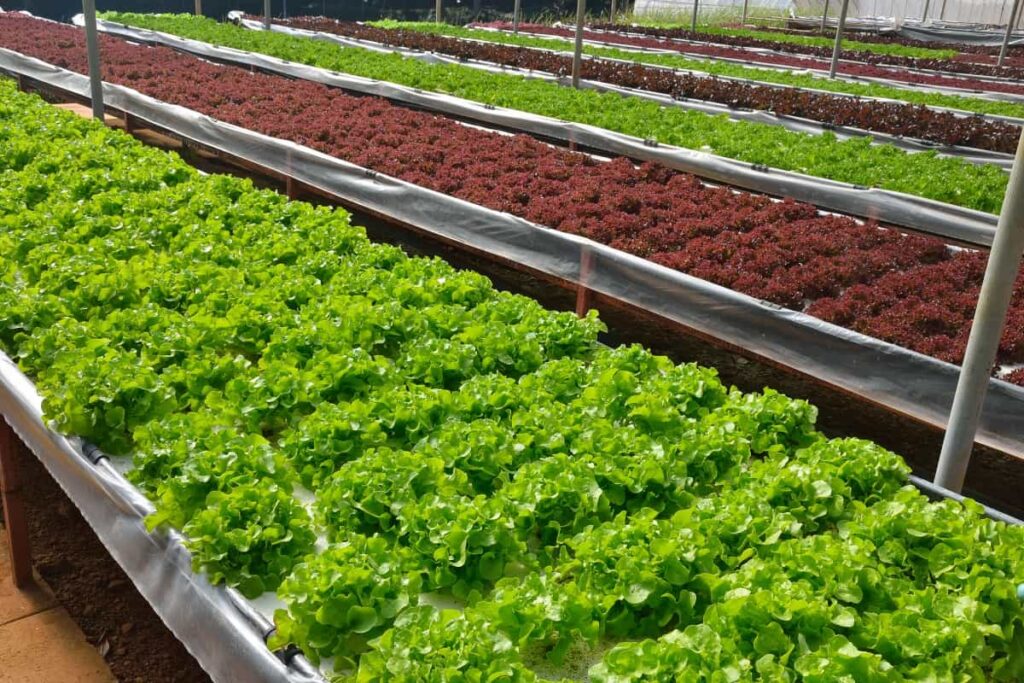
Scaling Up Hydroponic Lettuce and Salad Mix Operation
- Determine the scale of your hydroponic lettuce and salad mix operation based on available space and market demand.
- Invest in larger hydroponic systems like vertical farms or greenhouse setups to increase production capacity.
- Increase the number of nutrient reservoirs and growing areas to accommodate more plants.
- Source high-quality seeds or seedlings in larger quantities to meet the growing demand.
- Develop a systematic planting and harvesting schedule to ensure a continuous supply of fresh lettuce and salad mix.
- Optimize lighting and temperature control systems for larger growing spaces.
- Implement efficient water and nutrient management techniques to support a larger operation.
- Hire or train additional staff to manage the increased workload and ensure smooth operations.
- Expand distribution channels and establish partnerships with local markets, restaurants, or grocery stores to reach a wider customer base.
Conclusion
Growing lettuce and salad mix in hydroponics is an accessible and rewarding gardening method. Following the step-by-step guide, you can enjoy homegrown lettuce all year round, regardless of yard space limitations. Get started and embark on your hydroponic lettuce-growing journey today. These are some of the Lettuce and Salad Mix to grow in Hydroponics.
| Breen | Green Sweet Crisp/Salanova |
| Butterhead/Red Cross | Home Garden Mix |
| Butterhead/Rex | Kalebration Kale Mix |
| Cegolaine | Newham |
| Chicarita | Oakleaf/Rouxai |
| Elegance Greens Mix | Rosaine |
| Green Oakleaf |
- Budget Friendly Sheep Shed Ideas: Cheap and Low-Cost Tips
- How Much Do Cattle Farmers Make: Revenue Streams in Cattle Farming
- Management Pests and Diseases in Your Cotton Field
- Sheep Farming Business Plan for Beginners
- Aquaponic Farming at Home: A Step-By-Step Guide
- Profitable Village Farming Business Ideas in 2024
- High-Yield Aquaculture: Fast-Growing Fish for Farming
- Effective Fish Pond Construction Techniques for Beginners
- Irrigation and Water Management in Pineapple Farming
- Blossom to Harvest: Mastering Flowering and Pollination in Papaya Farming
- Pig Fattening Essentials: From Selection to Sale for Beginners
- Raising Wagyu Cattle: A Complete Guide for Premium Beef Production
- Soil Types and Their Water Holding Capacity
- Optimizing Irrigation Schedules for Coconut Groves for Enhanced Yield
- Espresso Your Garden: Coffee Grounds for Healthier Acid-Loving Plants
- The Best Soil Mix for Snake Plants: How to Mix Your Own Snake Plant Soil
- Green Thumb Success: Expert Tips for Cultivating Greenhouse Beans All Year Round
- Bloom All Year Round: The Ultimate Guide to Indoor Hyacinth Care
- Eco-Friendly Gardening: How to Make Liquid Fertilizer from Kitchen Waste
- Ultimate Guide to Grow Anise in Pots: Explore Seed Propagation to Harvesting
- Guide to Raising Chester White Pigs: Discover Breed Facts to Growth Management
- Mastering the Elegance: The Ultimate Guide to Weeping Cherry Tree Care, Planting, and Maintenance
- Ultimate Guide to Planting Garlic in Grow Bags: Growing Strategies for Beginners
- How to Fix Spider Plant Leaf-Related Problems: Natural and Organic Remedies
- 10 Reasons Why Your Tulsi Plant is Shedding Leaves: Home Remedies and Solutions
- Optimizing Growth and Yield: The Advantages of Palm Bunch Ash Fertilizer
- Utilizing Neem Oil Extract as a Natural Pesticide for Hydrangea
- From Soil to Harvest: Various Ways in Which Farmers Can Use AI Tools
- Steps to Encourage and Induce Citrus Flowers: A Comprehensive Guide
- How to Fix Snake Plant Leaf-Related Issues: Natural and Organic Remedies
- Transform Your Garden into a Fragrant Oasis with Raat Ki Rani (Night Blooming Jasmine)
- Discover the Ideal Chicken Breeds for Philippine Farms
- How to Create a Poultry Egg Farm Business Plan for Profits
- Grow Lemon Cucumbers Like a Pro: Insider Techniques for Bountiful Yields
- Ultimate Guide to Caring for Your Pink Princess Philodendron: Tips for Thriving Variegation
- Areca Nut Profit Per Acre: Calculating Yield and Cost of Cultivation
